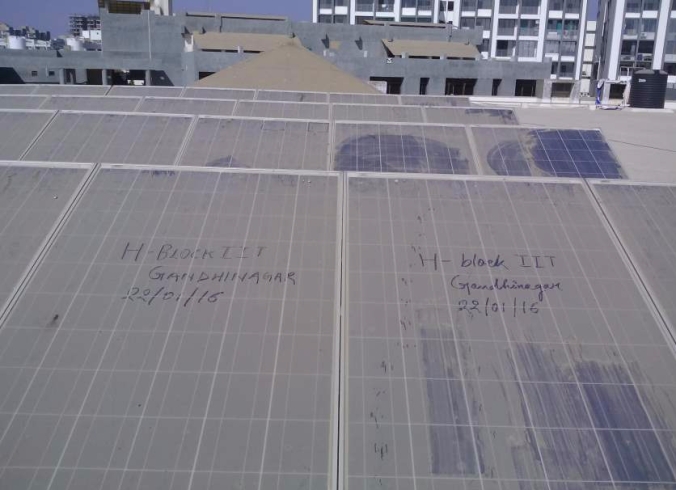
The study found an average 50% jump in efficiency each time the panels were cleaned every 20-30 days. – Photo: Chinmay Ghoroi
In India, particulate matter deposited on solar panels and present in the ambient air is responsible for about 17% reduction in solar power generation. This translates to about 2 GW reduction in solar power production for about 12 GW installed solar power capacity in the country. India has set an ambitious renewable energy target of 175 GW by 2022.
Particulate matter includes naturally produced ones like dust and man-made ones such as black carbon, brown carbon and organic carbon from biomass burning and fossil fuel.
Dust and non-dust particulate matter deposited on solar panels and present in the air prevent shortwave solar radiation from reaching the panels thereby reducing energy production.
The field study was carried out between January and March 2016 and samples were collected from multiple solar panels located at Indian Institute of Technology (IIT) Gandhinagar. The results were published in the journal Environmental Science & Technology Letters.
Analysis of samples collected from the solar panels revealed that dust accounted for 92% while the remaining fraction was composed of organic carbon, black carbon and ions produced from anthropogenic sources. However, per unit mass, the dust has less influence in reducing solar energy production compared with man-made particles. In fact, 92% dust and 8% of man-made particulate matter contributed to about 50% each to the total energy reduction.
“Owing to their larger size, dust particles have less influence on solar panel transmittance, and scattering by dust particles is also relatively less compared with the combustion-related particulate matter,” says Prof. Chinmay Ghoroi from the Department of Chemical Engineering at IIT Gandhinagar and one of the authors of the paper. “The smaller, man-made particles effectively block more light than natural dust.”
“The man-made particles are also sticky, making them much more difficult to clean off,” Mike H. Bergin from Duke University and the lead author of the paper says in a release. “You might think you could just clean the solar panels more often, but the more you clean them, the higher the risk of damaging them.”
The study found an average 50% jump in efficiency each time the panels were cleaned every 20-30 days. But if the cleaning is carried out once every two months, the efficiency decreased a lot.
The study suggests that regular cleaning of the panels alone will not be of much help if particulate matter, particularly man-made particles, is present in the ambient air. “Thus efficient emission control measures are required to maximise solar energy generation,” says Prof. Ghoroi.